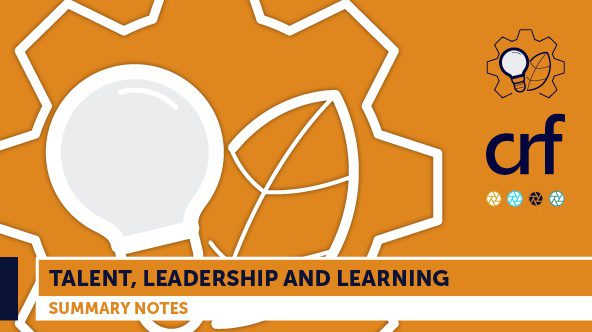Analytics and EBHR
TL&L Summary Notes: Culture Dashboards
On December 13th CRF convened an online discussion for its Talent, Leadership & Learning (TL&L) community on the topic of Culture Dashboards. The discussion focused on attendees’ experiences of culture dashboards and metrics, including successes, lessons learned and challenges they had experienced. The key takeaways from the discussion are summarised below.
- Measuring culture must start with a clear purpose tied to organisational priorities. Rather than simply monitoring activities, focus on tangible business outcomes and recognise that priorities may evolve over time.
- Measuring too many metrics can obscure the bigger picture. Combining varied data points collected across different timelines can also be challenging. Focus on what truly matters to your organisation and start by asking questions such as ‘what are we actually trying to measure?’ or ‘what do our metrics reveal about our progress?’ before considering more granular questions about data sources.
- Measure outputs, not activities. Effective culture measurement requires shifting from tracking activities to considering what actually drives action and measuring outputs accordingly. Attendees shared that they achieved this through prioritising visible behaviours over written values and considering metrics that drive behaviour, rather than only provide insight.
- Clearly define what is meant by “culture” and break this down into tangible areas that can be measured. Ultimately, culture boils down to behaviours: what you reward, tolerate and promote. Consider what areas of culture differentiate your organisation and measure in line with these.
- Consider how you will gather and combine multiple data sources. To what extent will you use existing data sources? How will you incorporate quantitative measures such as retention rates with more qualitative employee responses? Will you use existing survey questions or design bespoke questions? One attendee explained how they took standardised survey questions from an external vendor and discussed these with their executive team to adjust and prioritise areas critical to them.
- Senior leadership, especially the CEO, plays a pivotal role in prioritising culture metrics. Without their buy-in, culture risks being treated as an optional exercise rather than a driver of organisational success. Role modelling at the senior level is critical; leaders’ actions create ripple effects throughout the organisation, shaping norms that define the workplace culture. Metrics are also likely to be most effective when they reflect what the CEO and leadership team care about.
- Data-generated learnings are only meaningful if insights lead to changes in behaviours, systems or processes. For example, after-action reviews can be valuable tools, but their effectiveness depends on embedding lessons into updated practices. Focus on how to reflect on findings, experiment with approaches and create a process for acting on insights. Are learnings shared frequently or only in isolation? Do you have a process for embedding insights?
- Whilst data is essential, stories can inspire action. Stories concerning the positive or negative impact of behaviours can be powerful tools for shaping culture.One member shared how executive meetings included storytelling about where culture was thriving or failing, complementing quantitative metrics.
- Cultural metrics are most effective when tied to reinforcement mechanisms that drive accountability. One attendee shared how their organisation linked bonuses to team performance and mentoring outcomes, leading to improved collaboration and significant behavioural change.
- In order to achieve a meaningful culture shift, focus on a small number of priority areas and create a culture of psychological safety to ensure there is a culture of openness in reporting. One attendee provided an example of how changing the safety data they tracked from minor incidents to serious injury and fatality rates led to changes in behaviours and decision-making. By focusing on the more serious incidents they were able to learn where they can have greatest impact and where the system had the most room for improvement.
Further Resources
CRF. 2022. The Measurement of Culture and Culture Change.
CRF. 2024. The EBHR Toolkit.
CRF. 2024. HRBP Summary Notes: the Role of the Effective HRBP in Culture Change.
The next TL&L community event will take place in February 2025. To register your interest, or if you have any further questions, please contact communities@crforum.co.uk.
MEMBER LOGIN TO ACCESS ALL CRF CONTENT


